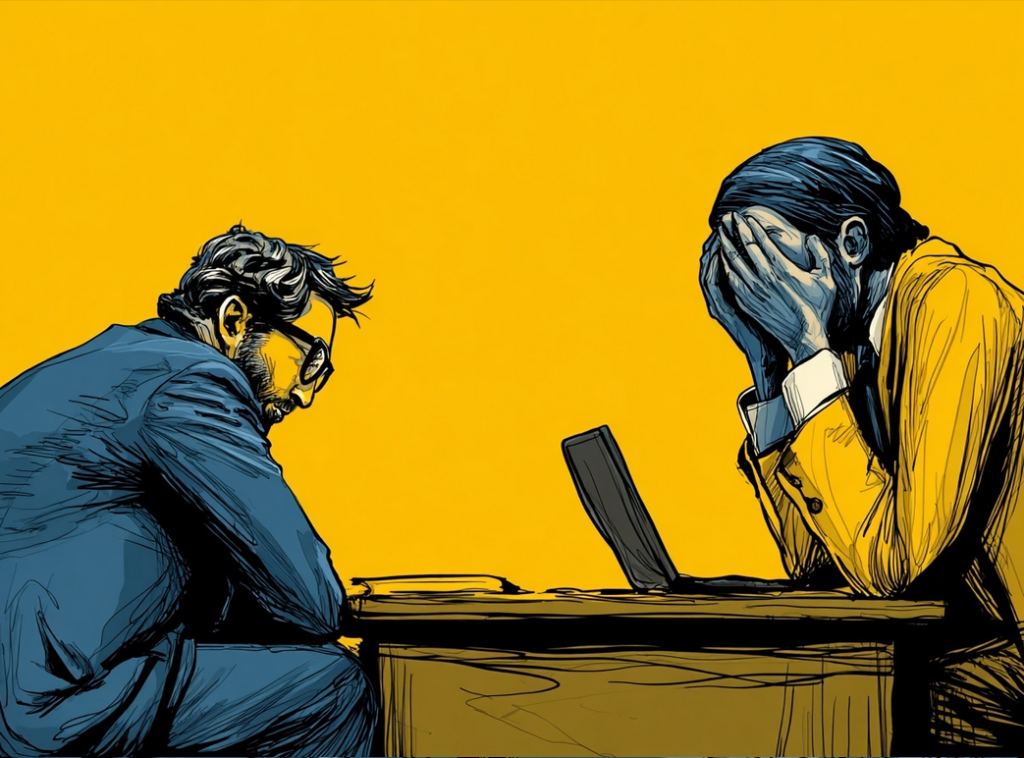You know that feeling when you’re three cups of coffee deep at 2 PM and your coworker who usually cracks jokes during standups has been silent for a week? Or when your normally detail-oriented teammate starts pushing commits with obvious bugs they would have caught months ago? Something’s off, but you can’t quite put your finger on it.
Welcome to the subtle art of spotting burnout in the wild. In our industry, where “hustle culture” and “shipping fast” are basically religious doctrine, burnout doesn’t always announce itself with dramatic breakdowns. More often, it creeps in quietly, disguised as temporary stress or a rough sprint. The developer who used to geek out over new frameworks now shrugs at everything. The designer who once volunteered for every project suddenly goes radio silent.
Here’s the thing: recognizing burnout early isn’t about playing workplace therapist or becoming the team’s unofficial HR department. It’s about being a decent human being who understands that sustainable careers in tech require looking out for each other. When we catch burnout early, we can actually do something about it. When we wait until someone’s already mentally checked out, we’re usually too late.
Understanding Burnout in Tech Context
What Burnout Actually Looks Like
Burnout isn’t your garden-variety Monday morning blues or the exhaustion that comes after a particularly brutal deployment. It’s a chronic state that researchers break down into three core components: emotional exhaustion, depersonalization (or cynicism), and reduced personal accomplishment. Think of it as your brain’s way of putting up a “closed for repairs” sign after months of running on empty.
In our remote-first world, burnout looks different than it did in traditional office settings. You can’t always see the physical signs like someone looking disheveled or falling asleep at their desk. Instead, you might notice that your teammate’s camera is perpetually off during calls, or their usual thoughtful Slack messages have been replaced with one-word responses. The energy that once drove passionate debates about code architecture has been replaced by a flat “whatever works” attitude.
The tricky part is distinguishing between temporary stress and chronic burnout. Everyone has rough patches, tight deadlines, and moments when they question their career choices. But burnout is different. It’s when someone who used to light up talking about their latest side project now seems indifferent to everything. It’s when problem-solving, which used to be energizing, becomes a dreaded chore.
Why Tech Workers Are Particularly Vulnerable
Our industry has some unique characteristics that make burnout almost inevitable if we’re not careful. The always-on nature of technology means we’re constantly accessible, constantly expected to be “up” for the next challenge. Slack notifications at 9 PM, weekend deployments, and the pressure to stay current with an ever-evolving tech stack create a perfect storm for exhaustion.
Then there’s the imposter syndrome that plagues so many of us. Technology changes so rapidly that last year’s expert can feel like this year’s beginner. The pressure to constantly learn, constantly prove yourself, and constantly adapt can be mentally exhausting. Add the myth of the “passionate developer” who should be grateful to code for a living, and you’ve got a recipe for people who feel guilty about setting boundaries.
The crunch culture that permeates many tech companies doesn’t help either. The glorification of all-nighters, the pride in “shipping fast and breaking things,” and the competitive atmosphere where working 60-hour weeks is seen as dedication rather than dysfunction all contribute to burnout becoming normalized.
Early Warning Signs to Watch For

Performance and Work Pattern Changes
The most obvious signs of burnout often show up in work quality first. That colleague who used to write clean, well-commented code might start pushing sloppy commits. Someone who never missed a deadline suddenly can’t seem to finish tasks on time. The attention to detail that once made them reliable starts slipping, and they begin making mistakes they wouldn’t normally make.
You might also notice changes in their work patterns. They could be working at strange hours, staying up late to make up for lost focus during the day. Others might go the opposite way — taking on way too much to prove their worth, overloading themselves and spiralling into a cycle of overcommitment and underdelivery.
These are the kinds of warning signs that Siren Training https://sirentraining.com.au/, a AU-based provider of first aid and mental health training for workplaces, teaches people to spot. Their Mental Health First Aid courses help teams recognise early signs of burnout, stress, or emotional distress. To check in, support, and guide colleagues towards the right help. With the right training, anyone in the office can be a mental health ally, even without a leadership title.
Communication and Collaboration Shifts
Burnout often affects how people interact with their team first, before it impacts their actual work output. Someone who used to actively participate in code reviews might start giving perfunctory approvals. The person who always had thoughtful questions during planning sessions becomes notably quiet. Their communication style might shift from collaborative to transactional.
Watch for changes in responsiveness too. If someone who usually replies to Slack messages within minutes suddenly takes hours or days to respond, that’s worth noting. Their tone might become more curt or formal than usual. They might start skipping optional meetings or team social events they used to enjoy.
Physical and Behavioral Indicators
Even in remote work settings, physical signs of burnout can be visible. Someone might look consistently tired on video calls, or their workspace might become noticeably messier than usual. They might start eating at their desk more often, skipping lunch breaks, or mention feeling sick more frequently.
Behavioral changes can be subtle but telling. They might start working through breaks consistently, or you might notice them online at unusual hours. They might begin declining social invitations or stop participating in team chat channels where they used to be active.
The Subtle Signs That Are Easy to Miss
The “High Performer” Burnout
The most dangerous type of burnout is often the quietest. Your highest-performing colleague, the one everyone depends on, might be burning out while still delivering quality work. They might be compensating for their exhaustion by working longer hours, maintaining their output through sheer force of will. This type of burnout is particularly insidious because it’s often invisible until it reaches a breaking point.
These team members might start showing perfectionist tendencies that border on paralysis. They might spend hours on tasks that used to take minutes, second-guessing every decision. They might take on additional responsibilities to prove their worth, creating an unsustainable workload that eventually collapses.
Remote Work Red Flags
Remote work has created new ways for burnout to hide. Someone might be struggling while appearing perfectly functional on video calls. They might be working from bed, skipping meals, or isolating themselves from their household while maintaining a professional demeanor during meetings.
Pay attention to changes in their virtual presence. If someone who used to have their camera on during calls suddenly keeps it off, or if their usual active participation in team channels decreases significantly, these could be signs of withdrawal. They might start scheduling meetings back-to-back to avoid having time to think about how they’re feeling.
What NOT to Do
Common Mistakes That Make Things Worse
When you suspect a colleague is burning out, your instinct might be to immediately offer solutions. Resist this urge. Telling someone to “take a vacation” or “you should relax more” minimizes their experience and suggests that burnout is a personal failing rather than a systemic issue. It’s like telling someone with a broken leg to walk it off.
Avoid immediately escalating to HR or management without talking to your colleague first. While your intentions might be good, this can feel like a betrayal and might make them more likely to hide their struggles in the future. Similarly, don’t start offering unsolicited advice about work-life balance or time management. They probably know what they should be doing, the problem is they lack the energy or resources to do it.
Avoiding the Productivity Trap
When someone is struggling, the worst thing you can do is pile more work on them because they’re “having trouble keeping up.” This creates a downward spiral where decreased performance leads to increased pressure, which leads to even worse performance. Similarly, don’t try to “help” by taking over all their tasks. This can make them feel useless and might create resentment from other team members who have to pick up the slack.
The temptation to ignore the problem and hope it resolves itself is strong, especially in remote work environments where it’s easy to avoid direct confrontation. But burnout rarely gets better on its own, and ignoring it often makes it worse.

Practical Ways to Help
Immediate Support Strategies
The most effective way to help a colleague who might be burning out is to create opportunities for genuine connection without making them feel like they’re under surveillance. Instead of asking “Are you okay?” which often gets an automatic “I’m fine” response, try more specific check-ins like “How are you feeling about the current project?” or “What’s been the most challenging part of your week?”
When offering help, be specific rather than general. Instead of “Let me know if you need anything,” try “I can handle the client call on Thursday if you want to focus on the technical implementation.” This removes the burden of having to ask for help while providing concrete relief.
Longer-term Colleague Support
Supporting a colleague through burnout is a marathon, not a sprint. Be a consistent, reliable presence without being overwhelming. This might mean checking in regularly but briefly, or remembering to ask about things they’ve mentioned in previous conversations. Help them reconnect with what they enjoy about their work by celebrating small wins and acknowledging their contributions.
If appropriate, advocate for them in meetings when they’re not present. This might mean speaking up when unrealistic deadlines are proposed or ensuring their good ideas get proper credit. Help them access resources like employee assistance programs or mental health benefits by sharing information casually rather than making it feel like an intervention.
Team-level Interventions
Sometimes the best way to help an individual is to improve the environment for everyone. Work to normalize conversations about workload and stress. Push back on unrealistic deadlines as a group rather than expecting individuals to advocate for themselves. Create better documentation and knowledge sharing to reduce the burden on key team members.
Establish practices that promote sustainable work habits. This might mean implementing “no meeting” blocks, respecting time off policies, or setting expectations about response times for non-urgent communications.
When and How to Escalate
Recognizing Your Limits
There’s a difference between being a supportive colleague and trying to be someone’s therapist. If someone is showing signs of serious mental health issues, if their work is significantly impacting the team, or if they’re expressing thoughts of self-harm, it’s time to involve professionals. You can’t fix burnout through friendship alone, and trying to do so might make you burn out too.
Involving Management Appropriately
If you decide to involve management, focus on work impact rather than personal details. Frame it in terms of workload distribution, project timelines, or team dynamics rather than sharing private conversations or speculating about someone’s mental health. The goal is to create systemic changes that will help, not to get someone in trouble.
Working with HR and Employee Resources
Most companies have employee assistance programs, mental health benefits, or other resources available. Learn what your company offers so you can share information when appropriate. However, don’t push someone to use these resources if they’re not ready. Your role is to provide information and support, not to manage their recovery.
Building a Burnout-Resistant Team Culture
Proactive Strategies
The best way to deal with burnout is to prevent it from happening in the first place. This means regularly assessing workload distribution, celebrating sustainable work practices, and making sure that “time off” actually means being offline. Recognize and reward team members who set healthy boundaries rather than those who consistently work overtime.
Creating Psychological Safety
Make it okay for people to say “I’m struggling” without fear of being seen as weak or unreliable. Remove stigma around mental health discussions by sharing your own challenges when appropriate. Build resilience as a team skill rather than expecting individuals to figure it out alone.
Moving Forward Together
Spotting and addressing burnout in colleagues isn’t about being a hero or fixing everyone’s problems. It’s about recognizing that we’re all human beings trying to build sustainable careers in an industry that often demands everything from us. When we look out for each other, we create environments where everyone can thrive long-term.
The ripple effect of supporting one colleague extends far beyond that individual. It creates a culture where people feel safe to be vulnerable, where asking for help is seen as strength rather than weakness, and where sustainable work practices become the norm rather than the exception.
Your role in making tech a more humane industry starts with paying attention to the people around you. It means valuing people over productivity, recognizing that our colleagues are whole human beings with lives outside of work, and understanding that taking care of each other is part of building great products.
Remember that burnout is a systemic issue that requires systemic solutions, but it’s also made up of individual experiences that deserve individual attention. By learning to recognize the signs early and respond with empathy and practical support, we can help create a tech industry where people don’t have to choose between their wellbeing and their careers.
The next time you notice that your usually chatty teammate has gone quiet, or your detail-oriented colleague starts making uncharacteristic mistakes, you’ll know what to look for and how to help. Because in the end, the best code is written by people who are healthy, supported, and sustainable in their work.

